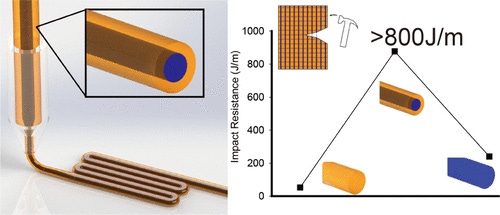Researchers at the University of Akron have modified starting materials to create tougher 3D-printed parts that can be used in manufacturing.
June 8, 2018

3D printing has advanced so that parts are now getting strong enough to be used beyond prototyping. Yet there are still weaknesses in 3D-printed objects that need to be addressed for them to be totally viable for full manufacturing use. To solve this problem, researchers at the University of Akron have developed a modification to the manufacture of the starting materials in parts fabricated using filament-based tools. In doing so, they claim that they can improve the toughness of 3D-printed parts.
“With standard polymers, the parts tend to have some voids remaining that significantly weaken the mechanical strength of the part,” explained Bryan Vogt, professor in the Department of Polymer Engineering at the University of Akron. His team addressed the problem by considering what limits the ability to remove the voids, he told Design News. They developed a structured, core-shell polymer filament in which a polycarbonate core acts as a stiff skeleton to support and reinforce the 3D-printed shape, Vogt said.
|
This graphic shows a modification, made by researchers at the University of Akron, to materials before they are 3D printed. The method uses a structured, core–shell polymer filament in which a polycarbonate core solidifies quickly to define the shape, whereas an olefin ionomer shell contains functionality (crystallinity and ionic) that strengthens the interface between the printed layers. This structured filament leads to improved dimensional accuracy and impact resistance in the resulting 3D-printed parts. (Image source: University of Akron) |
“By heating the plastic more, it will flow and fill the voids, but will also flow to deform the shape of the part,” he said. “We designed plastic filaments compatible with standard printers, including consumer hobbyist printers. We used two different plastics in a core-shell structure in the filament, where the core solidifies at high temperatures to maintain the shape of the part while the shell flows to remove the voids in the part.”
Specifically, the team created an olefin ionomer shell around the polycarbonate core, which improves and strengthens the connection between the printed layers. During testing, researchers found that printed parts with the filaments could withstand impacts without cracking, unlike parts made without them.
The new filaments developed by Vogt’s team help fabricate 3D-printed polymer-based parts that are on par with the strength of parts manufactured by current methods, he said. “We have been able to obtain impact resistance of 3D-printed parts that exceeds that of traditionally manufactured—or injection molded—polycarbonate,” Vogt said.
The printed parts with the new filaments developed by the team also are less susceptible to warping during printing, he added, as the stresses that develop during solidification are relaxed by the shell material.
RELATED ARTICLES:
Vogt said that the filaments can be manufactured with standard extruders and are fully scalable for manufacturing. “More importantly, these filaments are compatible with most filament-extrusion 3D-printing tools as long as the 3D printer can print the core material,” he added.
The team plans to continue its work to extend its concept to other polymer materials, Vogt said. “For example, polyolefins dominate traditional plastic manufacturing, but are not used in 3D printing,” he explained. “We are exploring if increased performance of 3D-printed parts can be achieved while using low-cost polyolefins in the filaments.” Researchers published a paper on their work in the journal ACS Applied Materials and Interfaces.
Elizabeth Montalbano is a freelance writer who has written about technology and culture for 20 years. She has lived and worked as a professional journalist in Phoenix, San Francisco, and New York City. In her free time, she enjoys surfing, traveling, music, yoga, and cooking. She currently resides in a village on the southwest coast of Portugal.
2017 Call for Speakers INSPIRE. COLLABORATE. INNOVATE. Atlantic Design & Manufacturing, part of the largest advanced design and manufacturing industry event on the East Coast, is the annual must-attend trade show for discovering the latest in 3D Printing technology! Source from the region's most comprehensive collection of cutting-edge suppliers, deepen your expertise with free, conference-level education, and network with thousands of professionals who can help you advance your projects — and your career. From prototyping to full-scale production, one lap of the show floor will help you overcome your toughest manufacturing challenges and keep you up to speed on innovations transforming the industry. Everything you need to take projects to market faster and more cost effectively is here. Click here to register for your free pass today! |
About the Author(s)
You May Also Like





